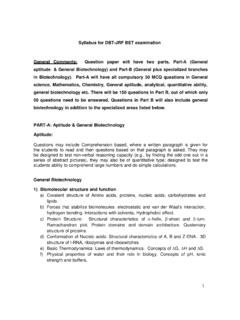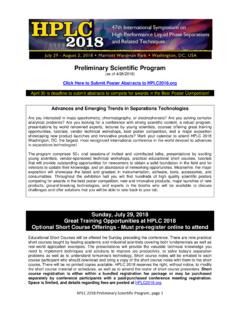Transcription of THE EVOLUTION AND DEVELOPMENTS OF …
1 Brazilian Journal of Chemical ISSN 0104-6632. Engineering Printed in Brazil Vol. 26, No. 02, pp. 227 - 249, April - June, 2009. THE EVOLUTION AND DEVELOPMENTS OF. IMMUNOSENSORS FOR HEALTH AND. ENVIRONMENTAL MONITORING: PROBLEMS. AND PERSPECTIVES. N. Bojorge Ram rez*, A. M. Salgado and B. Valdman Universidade Federal de Rio de Janeiro, Escola de Qu mica, Laborat rio de Biossensores, Centro de Tecnologia, Phone: + (55) (21) 2562-7315, Fax: + (55) (21) 2562-7567, Bloco I-164, Av. Hor cio Macedo 2030, CEP 21949-900, Cidade Universit ria, Ilha do Fund o, Rio de Janeiro - RJ, Brasil. E-mail: (Submitted: September 29, 2008 ; Revised: November 12, 2008 ; Accepted: December 9, 2008). Abstract - This paper is an overview of the recent DEVELOPMENTS in immunosensors, which have attracted considerable attention.
2 Immunosensors can play an important role in the improvement of public health by providing applications for which rapid detection, high sensitivity, and specificity are important, in areas such as clinical chemistry, food quality, and environmental monitoring. This review focuses on the current research in immunoassay methods based on electrochemical detection for the analysis of environmental samples or medical diagnostic methods with emphasis on recent advances, challenges and trends. Technological aspects in the development of immunosensors such as kinetics of biomolecular interaction, techniques of immobilization, simplification of assay procedures, immunointeration and catalytic studies and system miniaturization are presented Keywords: Immunoassay; Protein; Immunosensor; Bioengineering approach.
3 INTRODUCTION analyses and medical diagnoses; in particular, for the fast analysis of clinical preparations, for continuous Since the first biosensor of Clark & Lyons (Clark, monitoring in vivo of metabolites, proteins and in the 1992) aiming to detect glucose levels in serum preparations of drugs. samples, several analytes have been the aim of Antibodies are proteins, which are produced in detection by the development of many biosensors - animals by an immunological response to the analytical devices that include a biologically presence of a foreign substance (with a molecular sensitive element firmly immobilized or integrated weight larger than kDa), a so-called antigen into a physical transducer. Biosensors are one of the (Ag), and have specific affinity for this antigen. In most promising lines in the production of analytical conventional immunoassays, the wells of microtiter devices and monitoring.
4 There is no doubt that the plates or tubes are coated with either antibodies or practical use in the medical area, in the food industry antigens, and after addition of a sample containing and in the monitoring of toxic substances in the its complementary substance, an immunocomplex is environment has greatly stimulated the research and formed. For detection, a variety of labels is used. As development of biosensors. These researches were results of these assays very low levels are detected stimulated mainly by the demands of clinical (acceptable concentrations levels around 10-12 to *To whom correspondence should be addressed 228 N. Bojorge Ram rez, A. M. Salgado and B. Valdman ) of hormones, enzymes, virus, tumor automated and miniaturized. Their potential of antigens, and bacterial antigens (He et al.)
5 , 2009; commercialization is increasing, because they allow Camp s et al., 2008; Wang et al., 2008). solving great scale problems, such as problems in the The immune system is a theme of great interest in areas of health, pharmacy and environment. A. investigations due to its powerful capacity of comparison is also presented of the analytic information processing. The main objective of the capacities of several kinds of immunosensors, which immune system is to recognize all the cells or constitute a particular interest area of biochemical molecules in the system and to classify those cells as engineering. self or not-self defensive mechanisms. In these The biological materials can be selected in order assays not only the sensibility is considered, but also to satisfy analytic needs, operating in several the specificity.
6 The immunoassays are widely used in specificity levels. They can be highly selective, clinical analysis. However, other applications of specific for a narrow margin of compound, or to immunoassays of increasing importance have been show a wide specificity spectrum such as a sensitive observed in other areas, such as in environmental biosensor, for example, only to one antibiotic (for control (Michal et al., 2007; Rodriguez-Mozaz et al., instance, the gentamicin) or then to all the 2005; Velasco-Garcia, 2003) and in the quality antibiotics. This flexibility in selecting the biological control of food (Nandakumar et al., 2008; Skottrup et materials allows the user to adapt the biosensor to his al., 2008; Choi, 2005; Sadik et al., 2004; Gaag et al., or her needs. Biosensors based on the antigen.)
7 2003; Shan et al., 2002). antibody interactions or haptens as biosensitive The use of biosensors along the last 20 years has elements are called immunosensors, which combine been an approach for immunoassays which has had the sensitivity and specificity of immunoassays with important and interesting results (Skottrup et al., physical signal transduction. 2008; Zhu et al., 2005; Wang et al., 1998; Bergveld, Transducers convert the physical-chemical 1991). The production of analytic systems that model interaction between biomolecules and their specific and simulate living organisms for detecting the analytes into a signal, which is amplified and presence of certain kinds of substances or organisms registered as an analytical result. Immunosensors are is an area with a fast development; it is receiving built by means of the appropriate combination of the great attention in the scientific community in the last biomolecule (antibody polyclonal, antigen, hapten).
8 Two decades. In this new field, the development of with the transducer (electrochemical, amperometric, biosensors involves the identification and the potentiometric, piezoelectric, optical, etc.); used optimization of the analytic system, composed by together, they can be applied in specific analytical immobilized biological material, which interacts in a situations. In the classical biosensor, the receptor is specific way with one or more analytes; in the usually immobilized onto the transducer surface, interface with bio-electronics, this material is which enables it to detect interaction with analyte coupled to electrodes, which translate a specific molecules. In contrast to immunoassays, immunosensors interaction by the generation of a signal typically commonly rely on the reuse of the same receptor detected through electrochemical, piezoelectric or surface for many measurements.
9 It has already been optical means (Xu et al. 2008; Hirst et al., 2008; shown by various authors that the antibody layer was D'Amico et al., 2005; Turner et al., 1987). However, largely secured during sensor reuse, which might biosensors are different from the existing techniques imply an economic advantage of the immunosensor in at least two very useful and fundamental aspects: compared to commercial kit assays like ELISA The the first of them is the intimate contact of the reusability is evaluated as an important feature of biological material (whole cells, tissue, antibodies or biosensor. Between assays, the regeneration of the enzymes) with a transducer that converts the used immunosensor has been carried out by stirring biological signal into a measurable signal (The venot in basic solution (NaOH/NaCl) or more commonly et al.)
10 , 1999); and the second aspect is its functional by use of glycine/HCl buffer solution (pH 2 - 3) for size. The sensitive portion of a biosensor is usually few min, and then by washing with distilled water small and it allows small sample volumes and a several times to desorb the binding antigens. (Wang minimum interference with the existent processes Z. et al., 2008; Liu et al. 2008; Wang S. et al., 2008). after the implementation. Direct signal generation potentially enables real-time This review aims to explore key characteristic in monitoring of analytes, thus making immunosensors the design and development of immunosensors, with suitable tools for continuous monitoring. Also emphasis in the amperometric ones, which allow a factors such as progresses in microelectronics, fast and sensitive detection in a system that can be electrochemistry and production of optical fibers and Brazilian Journal of Chemical Engineering The EVOLUTION and DEVELOPMENTS of Immunosensors for Health and Environmental Monitoring: Problems and Perspectives 229.











